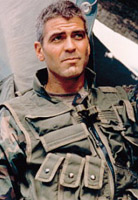SG-4
Col. Matthew Valentine, US Army
 Matthew Valentine grew up idolizing his father. Robert Valentine was a retired Army Sergeant Major, who had won the Congressional Medal of Honor during Vietnam in 1967, when Matthew was six years old. Matthew Valentine grew up idolizing his father. Robert Valentine was a retired Army Sergeant Major, who had won the Congressional Medal of Honor during Vietnam in 1967, when Matthew was six years old.
Ever since he could remember, all Matthew ever wanted to be was a soldier. He grew up very disciplined, and rarely got into trouble. However, his school record was never very outstanding, so that by the time he was in his senior year of High School the thought of going to college had never entered his mind. His only goal was to enlist. But his father insisted that he apply to West Point anyway. As it turned out, he was guaranteed admission based on his father’s being a CMH winner. Robert was ecstatic, and predicted his son would have a stellar career. What he didn’t know was just how prophetic that phrase would turn out to be…
After his graduation from West Point, 2nd Lt. Valentine was assigned to an infantry platoon in the 82nd Airborne Division. He spent three years with the 82nd, before volunteering for Special Forces Assessment & Selection. He was accepted and began a five year stint with Special Forces, the “Green Berets,” with the 10th SFG in Germany.
Upon being promoted to the rank of Major, he was reassigned to the Pentagon where he served as a liaison officer and intelligence officer. While at the Pentagon, he was exposed to many levels of national security, and was instrumental in designing and implementing several intelligence gathering protocols.
In the fall of 1997, his record of achievements and service got him noticed by several higher ups, and he was approached for an assignment to an unnamed, classified project. He was told his skills and experience would serve the project well, and the assignment would also include a promotion to the rank of Lt.Col. After a bit of thought, Valentine accepted the assignment, and was immediately introduced to General Hammond of Stargate Command.
Major Ray Osbourne, US Air Force Para-rescue
Ray was the only child of two doctors, Dianne and Ezekiel Osbourne. His parents worked hard, long hours, and left Ray alone for the most part. He had few friends, and so spent most of his time in a large empty house full of science and medical journals. Living mostly alone in his parents house with few friends has given Ray an odd personality and strange sense of humor.
Ray took pre med at his parents insistence, and then joined the Air Force at age 22 to spite them. Ray took to military life. His quiet and surreptitious nature made stealth easier for him than most. This and his medical knowledge earned him a place in para-rescue. After a sheltered life, Ray craved excitement. This often led him into more dangerous jobs and take greater risks than his peers. Ray was considered among the best in his field when he was contacted by higher ups about a classified assignment. Ray agreed with no questions asked. Ray was assigned to Stargate command, and given a post as part of SG-7. After a disastrous mission, leaving most of SG-7 dead or missing, Ray was reassigned to SG-4.
Captain Steven Kessler, US Air Force, Astronaut
Steven's obsession with faster than light travel started with his father. A technician at Muroc Air Force base, Jonathan Kessler would regale his son with tales of the X-1 and how he had watched "The Fastest Man Alive" as he sped into history. Growing up in Lancaster California, just outside of Edwards Air Force Base, it came as no surprise when Steve enlisted in the Air Force just after his High School Graduation. A scholarship to the Air Force Academy led to his Bachelors Degree in Physics.
Blessed with 20/10 vision similar to his idle Chuck Yeager, Steve showed an aptitude in flying that was unmatched. He spent several months working on and test flying an experimental flight plane (ironically an X-Model like those that once flew out of Edwards Air Force Base) before returning to the Air Force Academy for Post-Graduate Degrees.
His interest in Astrophysics seemed guaranteed to ensure him a place flying one of NASA's shuttles, and he published several papers on advanced theoretical Astophysics, stopping just short of finishing his Dissertation for a Doctorate in that field. This was somewhat overshadowed by another Officer who was in the same OCS with him, Samantha Carter, whose published works in practical Astrophysics and Dissertation on the matter were greeted with more acclaim.
Unfortunately, policy at NASA was changed before he had his chance to fly the shuttle. Only those with perfect 20/20 vision would be granted the coveted pilot seat. Still, his extensive knowledge of Astophysics took him to NASA, where he was able to go up a few times as a specialist among the crew. He worked on several experimental (and often classified) space vehicles intended to complement the shuttle for theoretical situations like Lunar flight and Mars Landings.
He ran into Major Carter again (a Captain at the time) at a lecture she was doing on theoretical wormhole physics, and took the time to catch up with her there. After small talk and what few minor details each could share of their respective assignments, she asked him why he hadn't gone on to finish his doctorate in Astrophysics. After relaying his dream of piloting the shuttle into space and to other worlds, and the minor policy detail which kept him from ever being able to achieve that dream, she offered her sympathies and mentioned she may have a solution to his problem...
|